Types and varieties of coleus
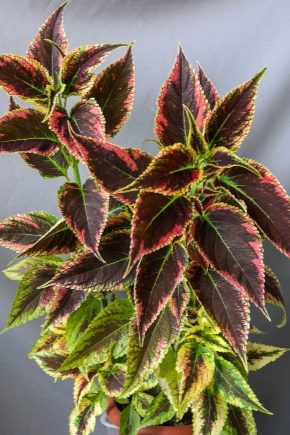
Perhaps, if you bring together several varieties and varieties of Coleus, it will be difficult to imagine that this is one and the same plant. Its height varies from 20 cm to 1 m, the color of the leaves is from pale beige to purple, almost black shades. Yes, Coleus is grown mainly not because of the beauty of the inflorescences, but because of the noble "appearance" of velvety leaves.
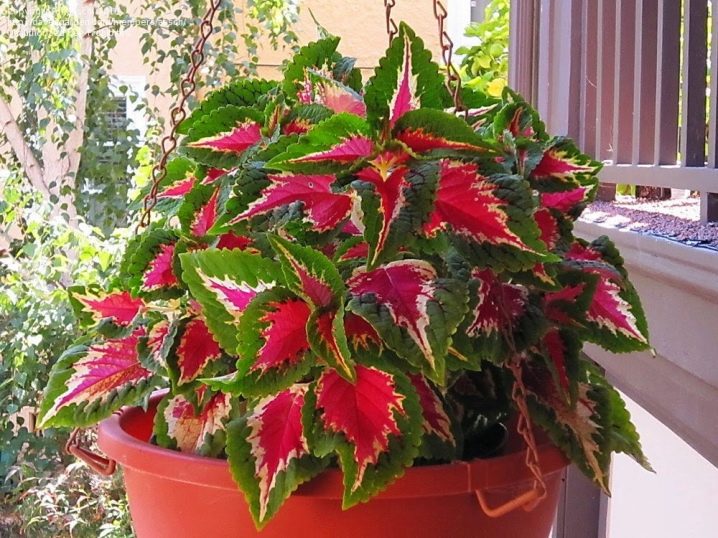
Peculiarities
Coleus are plants in the form of small bushes. Its distinctive feature is lush and numerous leaves, similar in appearance to nettles. However, Coleus boasts a variety of shades of these leaves. By the way, because of the similarity, Coleus is often called "nettle" among the people.
Another name - "poor man's croton", as if hinting at the fact that the beauty and luxury of the leaves of the plant can compete with the more noble - codiaum.
Coleus is grown both as an annual and as a perennial. Despite the fact that the tropics are considered its homeland, domestic flower growers and gardeners note the unpretentiousness of the plant, the ease of caring for it. In the wild, the plant reaches 50-100 cm in height. And, although it blooms, the leaves are still considered the main decoration of the nettles. His inflorescences are small and inconspicuous.
The plant has a light-loving disposition. With a lack of light, it changes the bright color of its leaves to faded. This can be observed in the winter. However, the bright color of the leaves at the same time allows the plant to protect itself from UV rays. However, despite such resistance, it is better to shade a tropical guest in the hot summer heat.
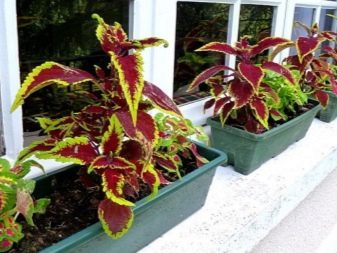

The optimum temperature for nettles is + 20… +25 degrees. At the same time, she is not afraid of minor temperature changes. The critical threshold for lowering the temperature is +12 degrees, the plant can die even during spring frosts. That is why the plant is planted in open ground at the end of May, when the earth and air are warmed up to 15-17 degrees.
In hot weather, Coleus requires moisture as the earthen coma dries. At the same time, the plant will tolerate a short-term drought more easily than excessive watering. Although, ideally, the earthen ball should always be slightly damp. In the summer heat, you can spray the air around the Coleus with water, avoiding moisture on the leaves. The latter should not be wiped off with a damp cloth, this can easily damage them.
Drip irrigation should be avoided. Before watering and after prolonged rains, it is recommended to loosen the soil... The plant is propagated by seeds or stem cuttings. Experienced gardeners usually resort to seed propagation, while the second method will be quite simple and understandable for everyone.
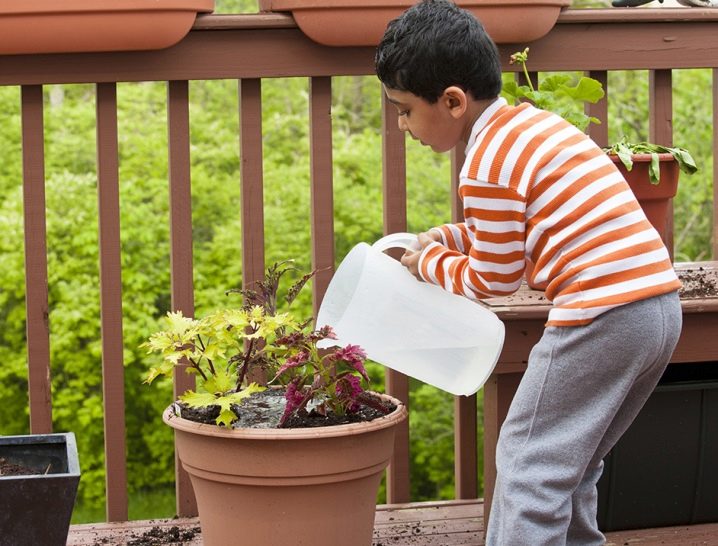
Main varieties
Coleus has up to 150 varieties. Let's consider the most popular among them.
Coleus Bluma
The plant was named in honor of the botanist Karl Blum, under whose leadership it was bred. It is a shrub up to 0.8 m high, with a tetrahedral stem and large, egg-shaped leaves. This species is the progenitor of most ornamental varieties. It is characterized by a rich palette of leaf shades. It comes in many shades, from purple and deep red to pale pink and white.
Suitable for growing in the open field, while being distinguished by unpretentious care and frost resistance (survives until the first autumn frosts). During the season, it produces many cuttings, which can first be rooted in water and then planted in the ground (during the summer) or rooted as a pot plant.
At the end of the growing season, the mother plant can also be transplanted into a pot and taken for the winter indoors, so that it can be planted again in the flowerbed in the spring.

Renelta
This variety includes all ampelous varieties of Coleus, which makes it possible to actively use the plant for decorating parks, loggias, terraces, shopping centers and offices. Sri Lanka is considered the homeland. When this variety was crossed with others, decorative ampelous varieties appeared, intended for home cultivation. This wren can be recognized by its characteristic color - a deep red color combined with green edging.

Hybrid
For convenience, all varieties of a hybrid variety can be conditionally divided into high, medium and low.
- Tall perennial Is a bush up to 60-80 cm high, formed by erect multifaceted stems. Leaves of hybrid forms can be varied - wide ovoid or narrower heart-shaped. Located on long petioles, opposite. They have wavy edges and a velvety surface, their color can be either monochromatic or variegated.
- Medium Coleus hybrid reaches a height of 30-50 cm. Can be grown outdoors and indoors. There are both relatively unpretentious and more capricious shrubs to care for.
For indoor cultivation, undersized hybrids (up to 30 cm) are usually chosen. In this case, the plant is more compact, resistant to reduced daylight hours.
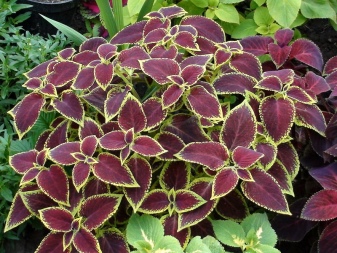
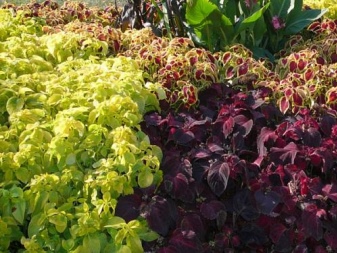
Forskolia
It is fair to single out the plant as a separate species. Today forskolias are actively used as a fat burning supplement. In the wild, it grows in the mountainous regions of Thailand, India, Nepal. The leaves are characterized by a high content of essential oils and therefore are very aromatic. The smell can be compared to the smell of camphor.
The plant is a shrub up to 70 cm high. In contrast to ornamental analogs, forskolias have not variegated, but monotonous green leaves. The color is more emerald, mint than grassy. It blooms with beautiful blue or lavender "spikelets".

Popular varieties
From Coleus Blum
- "Saber". Miniature shrubs, the height of which does not exceed 15-20 cm. They are characterized by the colorful color of the leaves - in the central part they are cherry-pink, and along the edges they are painted in a salad-yellowish color.
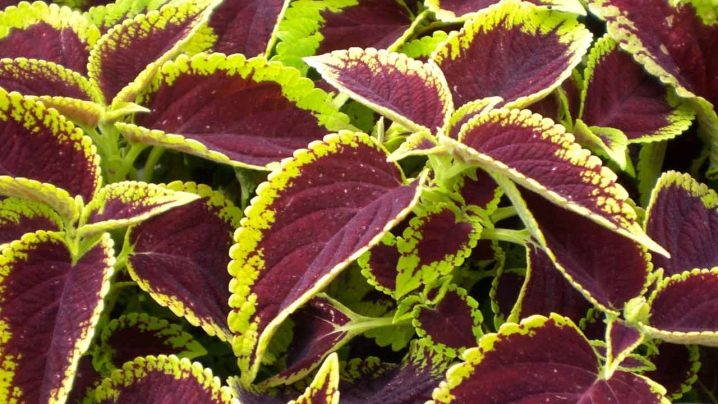
- "Black dragon"... One of the hybrid varieties of this variety. Spectacular shrub with deep purple, almost black corrugated leaves and light pink veins. They are velvety to the touch, jagged at the edges, they are both more rounded and oblong. The Velvet Night variety is often confused with this variety. The plants are really similar.
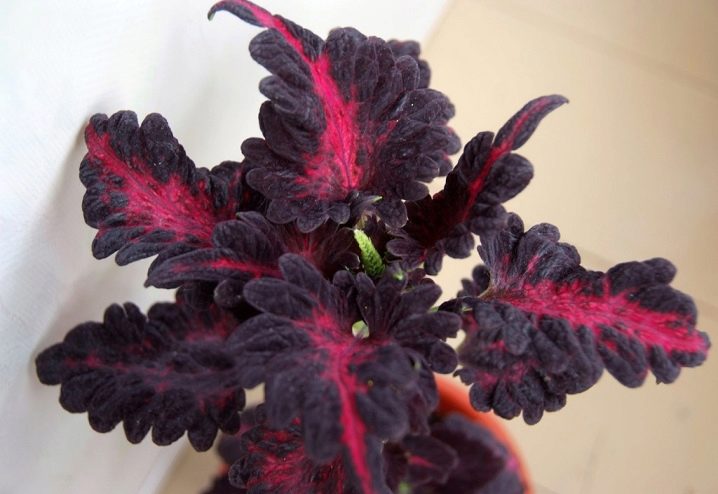
- "Velvet of the night" - these are the same velvety leaves of a dark purple hue. However, instead of pink streaks, they have a purple core.

- "Wizard". A small (up to 30 cm) plant with fluffy leaves. This variety has several varieties, each of which has a different shade.
- the variety "Wizard Jade" is distinguished by a white-green color, the main part of the leaf is milky white, gradually the color turns into a jade-emerald border;
- the variety "Wizard Vechernyaya Zarya" is a red-scarlet "foliage" with a gold rim along the edge;
- "Wizard Gold" surprises with yellow-golden color of leaves;
- Pinneaple Wizard has cherry-colored green leaves;
- "Wizard Scarlett" also known as "Wizard Velvet" (leaves are mostly cherry with a thin green-yellow rim).
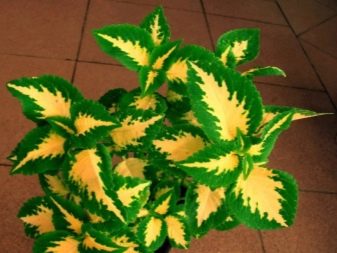

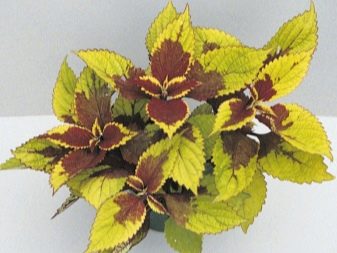
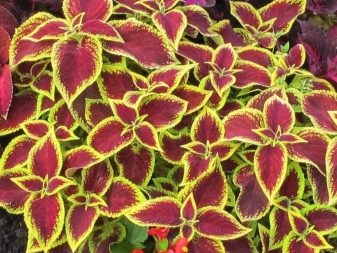
- "Butterfly". This species owes its name (translated from English - "butterfly") to the unusual shape of the leaves - they resemble the wings of butterflies.
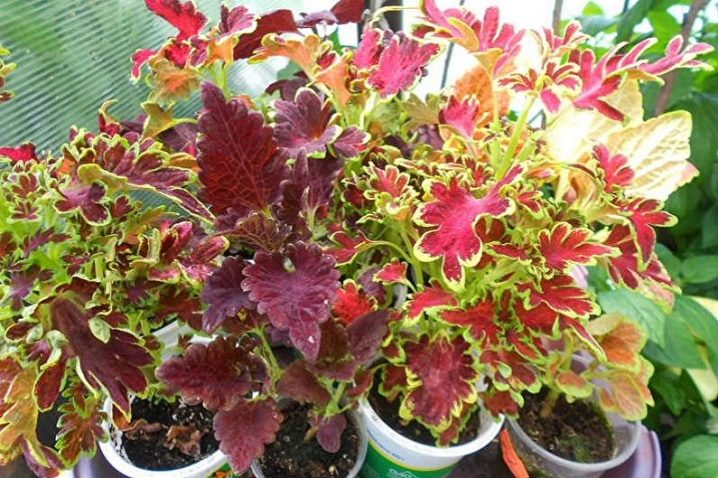
- Kong. This species got its name because of its large size - a tall shrub with long leaves looks impressive. In an adult plant, the width and height of the crown can be equal.
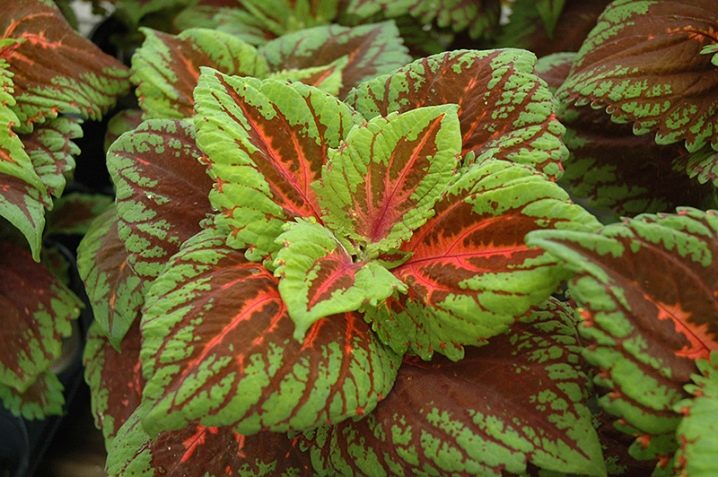
- Buttercup. Another "giant" among the Coleus. The height of plants of this species can reach 50 cm. Another sign is light green with white, sometimes almost completely white foliage.
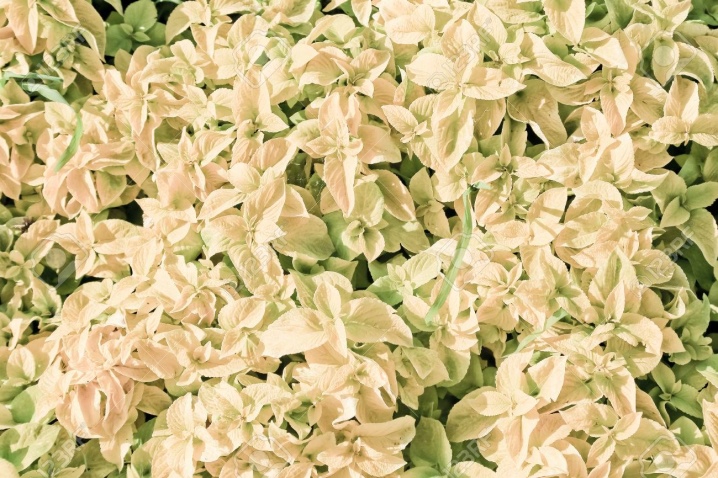
- "Burning Bush". The name of the plant is explained by the appearance of its leaves - they look like dancing tongues of flame, have an orange-yellow color.
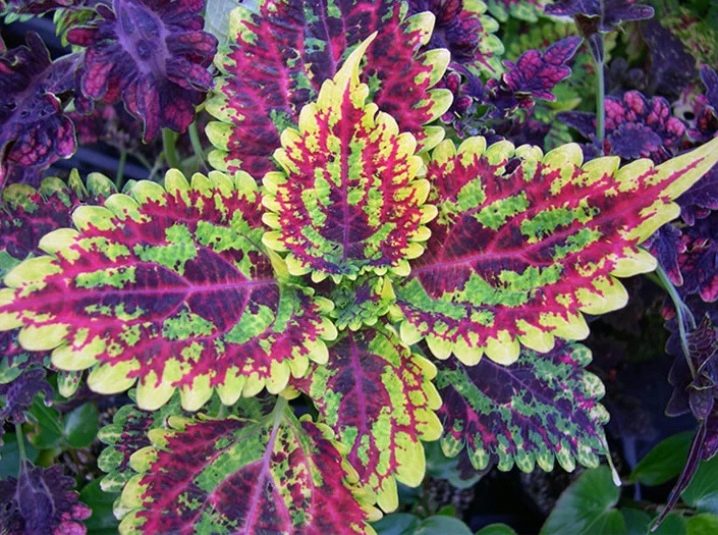
In flower beds, you can increasingly find carpet varieties - "Yulke" (beautiful undersized shrubs with dark green velvety leaves and a golden border) and "Gero" ("carpet" of dark purple leaves).
Ampel varieties or Coleus varieties of Renelt
- "Pumila". It is an ampelous shrub with recumbent stems. Due to the peculiarities of the location of the shoots, it can take on various shapes.
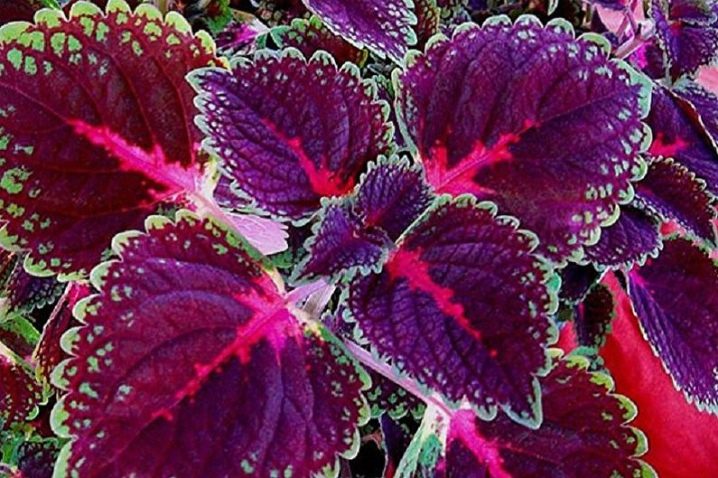
- "Reneltianus" and its variant "Reneltianus superbus". Indoor wren with reddish brown leaves and a green border around the edges. When properly cared for, these varieties bloom, emitting a delicate blue spikelet-like inflorescence.
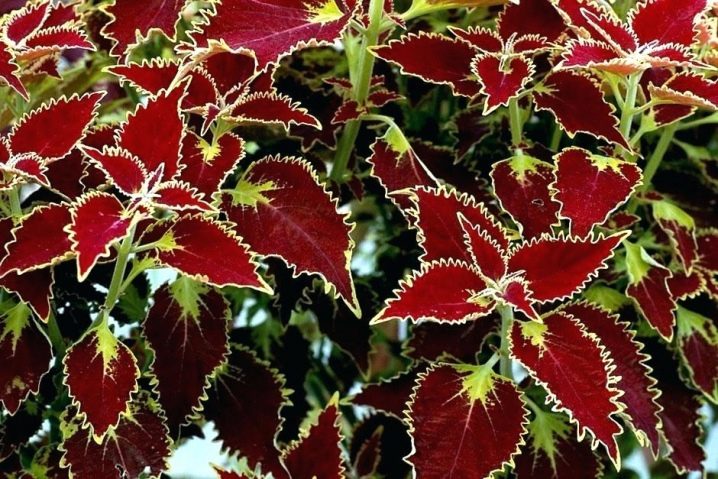
- Coleus Brilliant. An ornamental variety characterized by smaller leaves. At the same time, the shrub is covered with them very abundantly, which makes it look very luxuriant. Leaves can be lemon or burgundy.
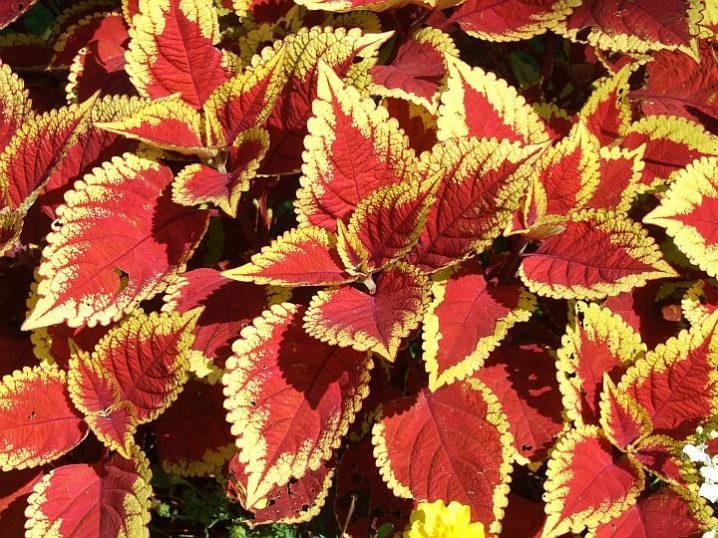
Hybrid varieties
- Carefree Series. A small shrub (height 25-30 cm) with corrugated leaves is the best option for growing in a pot.
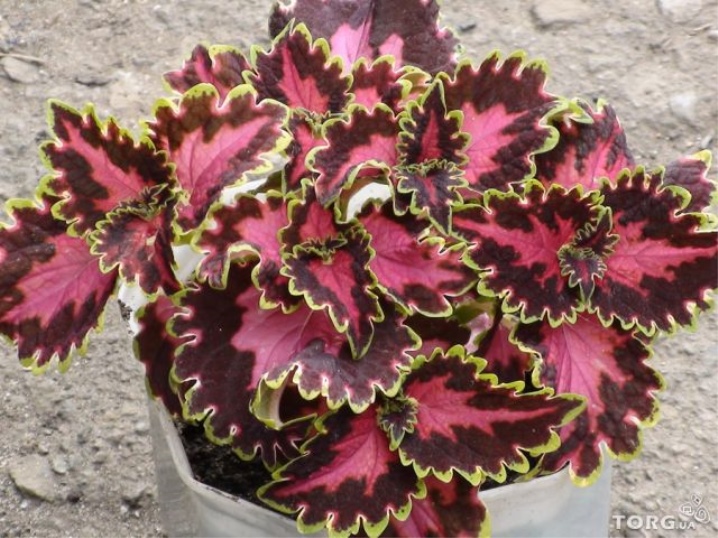
- Fairway Series. A highly branching hybrid, literally strewn with leaves. This makes the shrub look lush. Moreover, its height does not exceed 20 cm, and the number of leaf colors reaches 10 species. Among the most impressive are "Salmon Rose" (deep pink leaves with a green border), Ruby (scarlet leaves have a thin yellow border).


- "Rainbow". A hybrid variety, one of the "ancestors" of which is the Coleus Blum. Tricolor leaves have a dark pink center and a bright green border. The transition from pink to green is complemented by burgundy specks.
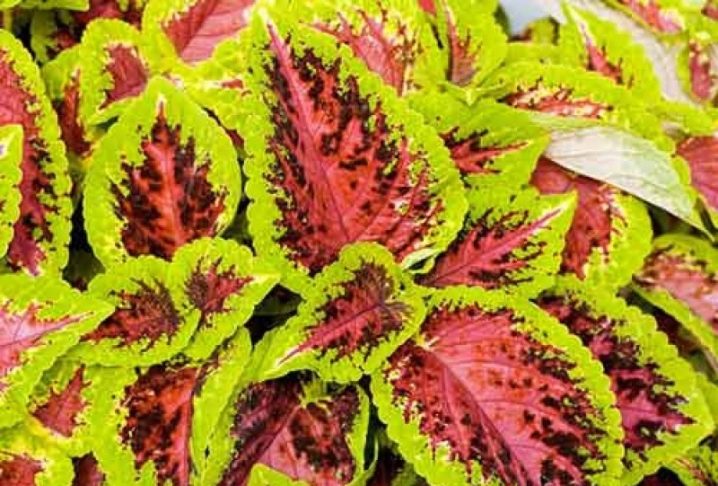
The hybrid varieties, which are resistant to diseases and unpretentious in care, also include "Dark Elf", "Morgan Le Fay", "Hot Embers", "Flamingo", "Hedwig".
Talking about unusual and popular varieties of Coleus, one should highlight "Henna". The leaves of plants of this variety are two-colored - on one side they are painted in a deep wine color, on the outside the leaves are greenish, with a golden dusting. Bonnie gold is a pale green leaf with a red border around the edge. The Pele variety also boasts an incredible "appearance". The leaves are painted in a pleasant light green shade and are covered with burgundy specks. The edges of the leaf are wavy, reminiscent of ruffles.
Connoisseurs of spectacular luxury should pay attention to the "Chocolate Mint" variety.
The plant has maroon, reddish-brownish leaves. A thin green stripe runs along the edge of the leaf, which seems to outline each leaf and emphasize its jagged edges.

For tips on caring for Coleus, see the next video.



































































































The comment was sent successfully.